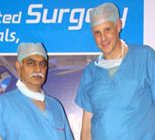To India, robotic surgery is something that is not as familiar as a critical heart surgery. Brought to use by the AIIMS in 2006 for the first time in Asia, robotic surgeries are very rare in India and its near neighbors. Recently, Krishna Institute of Medical Sciences, Hyderabad reopened the chapter of Robotic Surgery in India and made a landmark in ultra modern medical treatments. Under the diligent steering of MD, CEO of KIMS Dr. Bhaskar Rao, and guidance from Dr. James Peabody from Michigan several surgeries are performed since initiation, successfully.

Patients should welcome Robotic assistance in surgeries as it can extend great deal of comfort and freedom for a surgeon to operate a body. This eventually adds to the benefit of a patient. Dr. James says, “When people think of a robot they think there is something that is automatically working like in the car factory. In a car factory the operator might be on coffee break or reading a magazine while monitoring or operating a robot. But this is not the case with robotic surgery. The surgeon sits and in between the surgeon and the robot there is a lot of control and console.”
Talking about the Indian patient cognizance, Dr. Rao says, “Once they really know that the robot doesn’t perform it is the surgeon that is doing and you can approach the areas of much greater extent compared to hands, they accepted and now prefer it. Only factor they’re looking at now is cost. Costlier but with that they extract definite benefits especially a robotic operated patient can be discharged in first or second day after surgery unlike in conventional which takes 4 to 5 days. It’s not only the no. of days you need to stay is important but the recovery is much important. If recovery is faster the long term results of any particular person’s health will definitely be much better. So it is worth to go for this.”
The Robotic surgery systems offer a great degree of freedom and are used to make precise movements with the advanced movement scaling system that offers scaling like 2:1, 5:1 etc., tremors can be filtered out of the surgery by ably adjusting the movement scales. With the well built robotic arm a surgeon can reach a target at different angles that are inconceivable by a hand in conventional surgeries. “That’s good”, says Dr. James. With regards to the vision provided by robot, a magnification of 10X (maximum) is on offer and can be reduced to normal, 2X or 5X also. System vision is also equipped with an X-ray imager, Ultrasonic imager and an MRI, which provide a live diagnosis of the target tissue upon a simple toggle of a switch at the operator’s console. In addition to these integrations, the robot can be modeled for 3D video of target by featuring two lenses to the camera units. “There’s some advantage to this, ‘If you can view things better then you can do things better'”, says Dr. James.
Back in 1999, Dr. James and his boss initiated the process of bringing in use of robotic machines into treating prostate and other urological ailments for several patients. Surgeons who used and patients who underwent robotic surgery expressed a sigh of comfort which was never before in any sort of surgery. This brought in several other fields of medicine towards use of robotics and everyone started to try it. Eventually MI has been the centre of Medical Robotics. Dr. James says, “We have patients and doctors who are coming in from around the world. In the US when we started in 2000-2001 and 1% of prostrate surgeries were done robotically, by 2010 it is 70-80%. We thought we could do a better job for patients. Most of the medical research is made to find a better way to do a surgery.”
“Institutional collaboration is an important aspect in developing any indigenous technology rather than depending on foreign intelligence. “When cost and quality comes into picture, indigenous developments are much costly and are of compromise able quality. Medtronic people at Baroda developed a Pacemaker; it turned out to be more expensive than importing things. Even now, DRDO came forward to have a sort of research with KIMS, we already have a tie up for developing several things, maybe we include even this so that we can make it less expensive and more people will use it”, says Dr. Rao.
Dr. Rao, speaking about the future of robotic surgery in India and around says, “If you see healthcare scenario most of the operations are by hand. 20 years back there wasn’t any anesthesia and surgeons used ethane drops. Later on we had laparoscopic machinery. The advantage both from patient side as well as doctor side is the level of access to the infected target. Once in a while if we perform workshops like this we understand the advantages of this operation as well as the future benefits we get. Once few people get if done they tell the society that ‘yes I got operated by a robot and I feel much better ‘, then more and more people get motivated. They will taste definite benefits. Long ago few people started to have bypass surgeries here in India, and once they felt it is good the trend shifted from America back to India. Currently there are 12 robots in India; in future it might very soon touch 100. In next couple of years I expect the number touches 100 and after that it picks up fast.”
About further developments in robotic surgery systems, Dr. James ridicules that surgeons will not entertain a fully robotic surgery for job security reasons. Dr. James adds, “One other important aspect not available currently is the human touch sensation. Your hand and fingers when touch something will provide great amount of information. If something like a glove can be arranged if not for entire hand, at least for a finger to feel the tissue that a robo arm touches, not sure if it is feasible to perform, 10 years ago no one would have expected robotic assisted surgery but it is happening now, if we imagine something at some point of time it’s probably gonna happen, that kind of feedback would be good.” Dr. James also supposed to have in future a simulator fed with a series of MRI Images of several targets, visualize those and design a computer graphic and can make a practice station. Like an aircraft simulator. The training period can be shorter with such facility.
“Every human being is almost different from another in the world. Similarly human anatomy is also different in different bodies. So it is not so feasible to develop an autonomous robot and perform an autonomous robotic surgery.” says Dr. Rao, assuring the job of a doctor till a near future.




